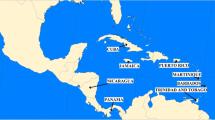Abstract
Purpose of Review
Leptospirosis is a worldwide zoonosis associated with high rates of morbidity and mortality. Its clinical expression is variable and can be particularly challenging to diagnose. Despite evidence of its transmission in Mexico, very little has been reported regarding human cases. The objective of our review was to describe the clinical manifestations of Leptospira strains present in Southeastern Mexico, and identify distinguishing characteristics from other endemic regions.
Recent Findings
We performed a review of state-reported cases from two large hospitals in Southeastern Mexico, an area suspected to have the highest incidence of the infection. Of 98 state-reported probable cases of leptospirosis, a total of 19 cases were confirmed serologically and further described here in an effort to highlight examples of reported cases to increased physician awareness. Patients had an average age of 40 years old, and were mostly female. World Health Organization-based classification according to the clinical expression, showed 12 cases with flu-like disease, 3 Weil’s syndrome, 3 with pulmonary hemorrhage/failure, and 1 with meningitis/meningoencephalitis. The average length of stay in hospital since the onset of symptoms to diagnosis varied according to the clinical presentation: 2.5 days for the flu-like syndrome, 3.3 days for Weil’s, 4 days for CNS involvement, and 16.5 days for pulmonary disease. Regardless of the category, renal and hepatic involvement was very frequent, even in patients with mild disease.
Summary
Leptospirosis in Southeastern Mexico is likely underreported, with the true disease burden being largely unknown. In this population, the most common presentation was a mild disease with good response to antibiotics. Patients with more severe disease had greater delay in diagnosis and negative outcomes. Understanding all possible expressions of Leptospira infections by health personnel is essential for improved decision-making.

Similar content being viewed by others
References
Papers of particular interest, published recently, have been highlighted as: • Of importance •• Of major importance
Bal AM. Unusual clinical manifestations of leptospirosis. J Postgrad Med. 2005;51:179–83.
Jin D, Ojcius DM, Sun D, Dong H, Luo Y, Mao Y, et al. Leptospira interrogans induces apoptosis in macrophages via caspase-8 and caspase-3-dependent pathways. Infect Immun. 2009;77:799–809.
Allan KJ, Biggs HM, Halliday JEB, Kazwala RR, Maro VP, Cleaveland S, et al. Epidemiology of leptospirosis in Africa: A systematic review of a neglected zoonosis and a paradigm for ‘One Health’ in Africa. PLoS Negl Trop Dis. 2005;9(9):e0003899.
Vijayachari P, Sugunan AP, Shriram AN. Leptospirosis: an emerging global public health problem. J Biosci. 2008;33(4):557–69.
Schneider MC, Jancloes M, Buss DF, Aldighieri S, Bertherat E, Najera P, et al. Leptospirosis: a silent epidemic disease. Int J Environ Res Public Health. 2013;10:7229–34.
Cárdenas-Marrufo MF, Vado-Solis I, Pérez-Osorio C, Peniche-Lara G, Segura-Correa J. A cross sectional study of leptospirosis and fetal death in Yucatan, Mexico. Colomb Med. 2016;47(1):11–4.
Alvarado-Esquivel C, Sánchez-Anguiano LF, Hernández-Tinoco J. Seroepidemiology of Leptospira exposure in general population in rural Durango, Mexico. Biomed Res Int. 2015. doi:10.1155/2015/460578.
• Sánchez-Montes S, Espinosa-Martínez DV, Ríos-Muñoz CA, Bezunza-Cruz M, Becker I. Leptospirosis in Mexico: epidemiology and potential distribution of cases. PLoS ONE. 2015;10(7):e0133720. Sanchez-Montes et al developed an ecologic niche modeling of leptospirosis geographic hotspots in Mexico which can be used by public health personnel to target interventions to areas at highest transmission risk.
Navarrete EJ, Rivas SB, Soriano RML. Leptospirosis prevalence and associated factors in school children from Valle de Chalco-Solidaridad, State of Mexico. Int J Pediatr Res. 2005;1:008.
KDIGO, AKI Work Group. KDIGO clinical practice guideline for acute kidney injury. Kidney Int Suppl. 2012;2:1–138.
Chidambaram N, Ramanathan M, Anandi V, Sasikala S, Innocent DJ, Sarayu L. Leptospirosis: clinical presentation and correlation with serovars. J Commun Dis. 2007;39(2):105–8.
•• Tubiana S, Mikulski M, Becam J, Lacassin F, Lefevre P, Gourinat AC, et al. Risk factors and predictors of severe leptospirosis in New Caledonia. PLoS Negl Trop Dis. 2013;7:e1991. Tubiana et al employed a case-control analysis of leptospirosis human clinical disease to identify predictors of disease severity which has translational value in a hospital triage setting.
Author information
Authors and Affiliations
Corresponding author
Ethics declarations
Conflict of Interest
Alejandro E. Svarch, Cesar Alejandro Arce-Salinas, Jose L. Amaya, and Melissa N. Garcia declare that they have no conflicts of interest.
Human and Animal Rights and Informed Consent
This article does not contain any studies with human or animal subjects performed by any of the authors.
Additional information
This article is part of the Topical Collection on Leptospirosis in Mesoamerica
Rights and permissions
About this article
Cite this article
Svarch, A.E., Arce-Salinas, C.A., Amaya, J.L. et al. Leptospirosis in Tropical Regions of Southeast Mexico: A Clinical Case Series Review. Curr Trop Med Rep 4, 52–56 (2017). https://doi.org/10.1007/s40475-017-0104-8
Published:
Issue Date:
DOI: https://doi.org/10.1007/s40475-017-0104-8




